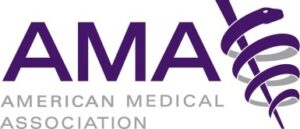February 24, 2022 – In a national address today, American Medical Association (AMA) President Gerald E. Harmon, M.D., marked two years of the COVID-19 pandemic in the United States and outlined specific actions to fix our ailing health system, rebuild trust, and better respond to the next major public health emergency. The speech, titled “America’s Twin Pandemics – Defeating COVID-19 and Rebuilding Trust” and delivered via livestream from the National Press Club, addressed medical misinformation, health system burnout and steps to improve our health infrastructure.

“As a doctor and a veteran, I have some experience with physical and emotional trauma. I know the signs, and what to look for,” Dr. Harmon says in remarks, as prepared for delivery.
“It’s my opinion, two years into this tragedy, that our nation is suffering a type of battle fatigue from our long fight with COVID, and the full impact of this pandemic on our national psyche may not be known until long after this difficult period ends.
“And it will end … eventually.
“Our actions now can reshape our U.S. health system to better meet the needs of all people, not only the brave men and women in the medical workforce, but also everyone who relies on our health system for the fulfillment of a long and healthy life.
“COVID-19 will be with us for the foreseeable future, and we must understand what that means and make every effort to protect the most vulnerable among us.”
The complete text of the speech, as prepared for delivery, is below.
America’s Twin Pandemics – Defeating COVID-19 and Rebuilding Trust
This month marks the two-year anniversary of the first known death to COVID-19 in the United States and there isn’t a single person I know who isn’t worn out … frustrated … or just physically exhausted. We’ve experienced trauma, lockdowns, economic difficulties, and at least five distinct viral surges.
That goes double for our nation’s physicians, and our entire health care workforce, who have been under siege from the earliest days of this pandemic.
We all been hurt in different ways. Many have lost loved ones to COVID-19. The country is moving quickly toward one million dead from this virus. This is a heartbreaking tragedy that is unlike anything we’ve experienced in our lifetimes.
Many have lost their jobs, and the financial security that comes with that. Many have missed out on education … or postponed weddings or other important celebrations. And most painfully, some have been unable to comfort dying loved ones or even properly memorialize them at funerals.
All of us have lost time with those close to us … and we have had our lives totally upended.
I have been a family doctor in South Carolina for nearly 40 years. I am also an Air Force Veteran, and proudly served our country in the medical arena in the Global War on Terror and overseas operations after 9/11.
So, as a doctor and a veteran, I have some experience with physical and emotional trauma. I know the signs, and what to look for.
It’s my opinion, two years into this tragedy, that our nation is suffering a type of battle fatigue from our long fight with COVID … and the full impact of this pandemic on our national psyche may not be known until long after this difficult period ends.
And it will end … eventually.
We are seeing many states lifting public health mitigation measures such as indoor mask wearing … and while this represents a new phase of the pandemic, it’s critical that such important decisions about public health are rooted in science and data and not driven by political pressures.
Every one of us is eager to bring this painful chapter to a close.
But how we emerge from this pandemic … the lessons we learn and apply moving forward … the causes we fight for … will go a long way toward preventing the next great health crisis from gripping our country.
Our actions now can reshape our U.S. health system to better meet the needs of all people … not only the brave men and women in the medical workforce, but also everyone who relies on our health system for the fulfillment of a long and healthy life.
COVID-19 will be with us for the foreseeable future, and we must understand what that means and make every effort to protect the most vulnerable among us.
That means becoming fully vaccinated against the virus, and receiving booster shots when eligible.
And it means vaccinating our children, when they are eligible. I encourage anyone with questions to talk to their doctor or another trusted health professional about the safety and efficacy of COVID-19 vaccines.
We must do everything within our power to protect ourselves and those close to us as this virus evolves. If we do that, we will ease the extraordinary pressure on the frontline workers in our hospitals, and make it easier for everyone to receive the medical care that they need.
Whatever the new-normal looks like at the end of this pandemic, we should all agree that it cannot look as it does now, where our hospitals are consumed with those needing care for COVID-19, and might be pressed to limit care for patients with other diseases. That simply cannot happen.
Let’s talk about what we have learned during this pandemic, and what needs to happen to create a health system that honors those we have lost to COVID and better prepares our nation for whatever comes next.
This work starts with a focused and comprehensive effort to rebuild trust in science, in medicine, in government, and in the public health agencies we rely on for credible, evidence-based information.
Sadly, COVID-19 isn’t the only pandemic we are fighting in America.
The other pandemic is a profound loss of trust in the advice of experts, including doctors and scientists, to help us make sense of what’s happening and make informed decisions about our health.
This pandemic of mistrust was probably beginning before COVID-19, but the extreme polarization during this crisis has profoundly hampered our nation’s ability to respond. It is a major reason why the U.S. has a far higher death rate from COVID-19 compared to other well-resourced countries.
There have been numerous and well-documented missteps prior to and since the start of the pandemic that have understandably contributed to this environment of distrust.
- Inadequate funding of pandemic preparedness and public health agencies;
- Unclear lines of responsibility;
- Uneven use of federal authority to produce masks and PPE, as well as testing and supplies;
- Mixed messaging on masks, social distancing; isolation and quarantine;
- Political – and even personal – attacks on scientists and physicians;
- And most recently an inadequate response to the Omicron surge and a shortage of tests more than 18 months into the pandemic;
Playing the blame game is an exercise in futility, but we do recognize these missteps. Our focus now should be learning from those mistakes and rebuilding the trust lost as a result.
One way to begin rebuilding trust in science and medicine is to effectively counter those voices who spread easily disproven and blatantly false information online.
Surprisingly to me, some of the loudest purveyors of misinformation and junk science during this pandemic have been a very small number of doctors and health professionals.
These offenses are, in my opinion, the most egregious of all because they violate the ethics of our profession and each lie and untruth spread by the click of a mouse erodes the trust that is at the very heart of the patient-physician relationship … trust that is essential in our ability to provide care.
This is why the AMA has called for state medical boards to respond swiftly when physicians spread falsehoods online and through the media, particularly disinformation relating to COVID-19.
It is critical that state licensing boards do their part by stepping up their vigilance for this kind of behavior that undermines public health and vaccine confidence.
What’s more, we strongly encourage policymakers to explore appropriate methods of limiting the spread of disinformation and ensuring there is accountability and consequence for those who do so.
Similarly, AMA urges media outlets, including influential social media companies and streaming services, to remain vigilant to help their readers, viewers and listeners more easily separate fact from fiction and reduce misinformation.
This can be accomplished while upholding the principles of the First Amendment that we all hold dear.
We continue to call on our public health agencies to base decisions on scientific evidence, data, and equity.
And for our government’s scientific institutions, now and in the future, to be led by experts in their fields, not by political agendas… and for the actions made by our government leaders to be guided by the best available evidence.
We all must work to reassure the public that the information they hear and read is reliable … that it is rooted in science and data … and that they can trust it with their lives.
Today, the AMA calls for five specific actions to fix our ailing health system, rebuild trust, and better respond to the next major public health emergency. And there will be one!
The first is to enhance our state and federal stockpiles of medically necessary supplies and improve the system for acquiring and distributing them. The shortage of PPE and other essential supplies in the early months of this pandemic slowed our nation’s response and needlessly put lives of physicians and our frontline workers at risk.
Given what we have experienced in this pandemic, global demand can quickly outpace supply for even simple items, such as cotton testing swabs.
This should never happen in a country as rich in resources and manufacturing as ours.
We call on Congress to work with federal agencies to build our domestic manufacturing capacity, utilizing public-private partnerships to quickly accelerate production.
We urge that our nation create a transparent plan for obtaining and distributing PPE and other needed supplies, with clear delineation of federal and state roles.
And we call for increasing funding and improving planning for the Strategic National Stockpile, creating contingency plans and providing federal guidance on what should be stockpiled and what should be provided to states and local entities in a crisis.
Second, we must significantly increase funding to bolster our nation’s diminished public health infrastructure.
Chronic disinvestment in government public health agencies puts lives at risk and has severely limited our ability to fight COVID-19. State public health spending has dropped 16 percent over the last decade, resulting in the loss of nearly 40,000 jobs at state and local public health agencies.
It’s gaps like these at the community level that contributed to a lack of widespread testing, resulting in more-rapid virus spread in the early stages of the pandemic. And our inability to perform large-scale genetic sequencing allowed for dangerous new variants to spread without detection.
A robust public health infrastructure is our nation’s best defense against infectious disease.
It is critical that we invest what is necessary to increase staffing and upgrade essential functions, such as public health surveillance, which will make it easier to respond to emerging threats and better educate the public how to best protect themselves in a crisis.
Third, we must learn from the process that led to the rapid-scale production of several safe and highly effective vaccines.
Operation Warp Speed is, quite simply, one of the greatest scientific achievements of our lifetime. We believe the public-private partnership and operational structure of this plan should be preserved in some form for future pandemics … or any time vaccines and therapeutics are needed in an emergency.
Fourth, the rapid expansion and integration of telehealth and remote patient care has been a lifeline during this pandemic … not only for patients but for struggling physician practices during periods of intense lockdowns.
The AMA has long championed telehealth and has provided expert guidance, support and resources to help physicians implement it in their practices during the pandemic.
But for telehealth to succeed the way patients and physicians want it to, we need the help of Congress. The AMA strongly supports the Telehealth Modernization Act and applauds its inclusion in the second Cures Act.
For the rest of this pandemic and beyond, Medicare patients must retain the ability to access telehealth services from their doctors without arbitrary restrictions.
And finally, we must pause to consider the extraordinary pressure our nation’s physicians and health care workers have had to shoulder the last two years … men and women on the frontlines of our emergency departments and Intensive Care Units who have gone above and beyond in their service to all of us.
They have worked extremely long hours, often for days at a time … through every surge … at great personal risks to themselves and their loved ones. I promise you I have personally been there as recently as this past December.
Far too often, and with increasing frequency, they have become targets of violence and intimidation from an angry and equally anxious public.
This cannot be our future – and should not be our present.
We owe physicians and health care workers much more than our love and appreciation.
We owe them our most sincere efforts to fix the problems that have plagued our response to COVID-19 … and to work with them to solve common frustrations that are driving so many out of the profession.
As a nation, we are beginning to open our eyes to the mental health needs of physicians.
The AMA commends Congress for passing the Health Care Provider Protection Act.
This legislation is named for Dr. Lorna Breen, the New York City emergency room physician who sadly took her own life in 2020 after weeks of intense and psychologically grueling duty providing care for many COVID-sick patients in her Manhattan hospital.
This Provider Protection Act will help raise public awareness of the mental health needs of physicians and dedicate federal resources to create evidenced-based programs to better support physicians and other health care workers.
This action is long overdue.
An article in December in Mayo Clinic’s Medical Journal confirmed our worst fears about what this pandemic and other stressors are doing to our health care workforce.
The report, based on a broad survey of medical professionals last year, showed that one in five doctors said they planned to leave the profession within the next two years, and many more planned to reduce the hours they worked.
The reasons they cite would be familiar to anyone who practices medicine today, including a long list of administrative burdens and an overly bureaucratic system that leaves physicians feeling completely powerless and removed from what we do best … caring for our patients.
And these problems like others I’ve mentioned existed long before COVID-19 pushed many of us to the breaking point.
Our nation needs a hard reset on how we nurture and grow our physician community, with an eye toward increasing not only its size but diversity.
We need to expand the number of residency training slots for med students and remove caps to Medicare-funded positions to bolster our physician workforce.
We need to alleviate one of the largest barriers that keeps more bright young students from pursuing medicine – the exorbitant cost of a medical school education.
The average young doctor in the U.S. leaves school with almost $200,000 in debt, which often drives them to seek higher-paying positions in larger cities and contributes to physician shortages in rural areas.
And we must build a better education infrastructure with pathways to encourage more young men and women from diverse backgrounds to pursue medicine as a career.
Almost one in three people in the U.S. come from historically marginalized communities, but fewer than one in eight are physicians. This has to change.
The AMA has spent nearly a decade convening leading medical institutions through our Accelerating Change in Medical Education and Reimagining Residency initiatives.
We also have a number of efforts underway to increase physician diversity, including through scholarship assistance, mentoring and other pathways … but here too we need a concerted federal effort and resources to make this a priority.
That’s why the AMA is urging Congress to provide appropriate funding to support the creation and sustainability of medical schools and residency programs that have their roots in educating diverse populations, including at Historically Black Colleges and Universities, Hispanic-Serving Institutions, and Tribal Colleges and Universities.
To meet the unique challenges of health care in the 21st Century, it is essential that we build a physician community that better reflects the growing diversity of our patients.
No amount of planning or investment that we make can completely eliminate the next viral threat.
But America is blessed with tremendous resources. We have the best-equipped, best-educated, and best-trained doctors in the world.
We have brilliant, pioneering researchers pushing the boundaries of science.
And after two years fighting COVID-19, we have a renewed sense of ourselves, the communities in which we live … and what we must do to rebuild trust . . .
… to create a health system that is more inclusive of diverse populations and their needs …
… more accessible to all …
… more supportive of physicians and health care workers …
… more flexible and better able to respond in a crisis.
We have no choice but to learn … to grow … to change … and to adapt to the health threats that are inherent in our increasingly connected world.
We have come too far as a nation not to learn from the past two years.
Now is time to “Act Worthy of Ourselves.”

























